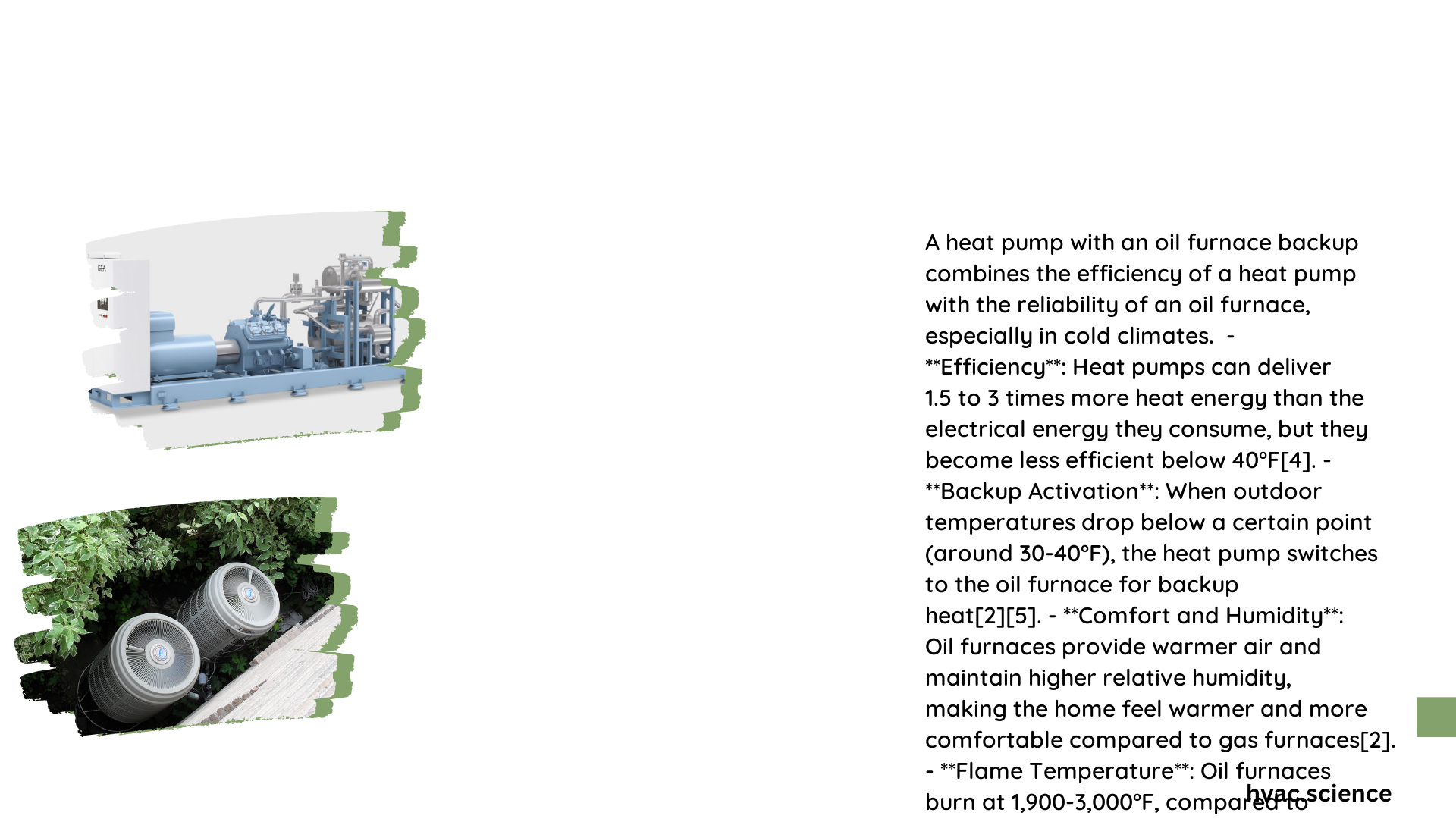A heat pump with oil backup combines the efficiency of a heat pump with the reliability of an oil furnace. This hybrid system uses a heat pump as the primary heating source, switching to an oil furnace during extremely cold temperatures. This combination offers energy efficiency, cost savings, and consistent heating performance across various weather conditions.
What is a Heat Pump with Oil Backup?
A heat pump with oil backup is a dual-fuel heating system that combines an electric heat pump with a traditional oil furnace. The heat pump operates as the primary heating source during moderate temperatures, while the oil furnace takes over when temperatures drop below a certain threshold.
How Does This System Work?
- The heat pump extracts heat from outdoor air and transfers it indoors.
- When outdoor temperatures fall below the heat pump’s efficient operating range, the system switches to the oil furnace.
- A control system manages the transition between the two heat sources based on outdoor temperature and heating demand.
Why Choose a Heat Pump with Oil Backup?

Choosing a heat pump with oil backup offers several advantages:
- Energy efficiency during moderate temperatures
- Reliable heating in extreme cold
- Potential cost savings on energy bills
- Reduced environmental impact compared to oil-only systems
What Are the Key Components of This System?
The main components of a heat pump with oil backup system include:
- Heat pump unit (outdoor and indoor)
- Oil furnace
- Control system
- Thermostat
- Ductwork
How Efficient is a Heat Pump with Oil Backup?
The efficiency of a heat pump with oil backup system is measured using different metrics:
| Metric | Description | Typical Range |
|---|---|---|
| COP (Coefficient of Performance) | Ratio of heat output to energy input | 2.5 – 3.8 |
| HSPF (Heating Seasonal Performance Factor) | Seasonal heating efficiency | 7.7 – 12+ |
Heat pumps are generally more efficient than oil furnaces at moderate temperatures, with COPs ranging from 3 to 3.8 at 47°F. However, efficiency decreases as temperatures drop, which is when the oil backup becomes crucial.
What Are the Installation Requirements?
Installing a heat pump with oil backup requires:
- Proper sizing of both the heat pump and oil furnace
- Integration of control systems
- Modification of existing ductwork (if necessary)
- Professional installation by certified HVAC technicians
How Much Does It Cost to Install?
The cost of installing a heat pump with oil backup can vary widely based on factors such as:
- Equipment quality and efficiency ratings
- Home size and existing HVAC infrastructure
- Local labor rates
On average, you can expect to pay:
- Heat pump: $3,000 – $10,000+
- Oil furnace: $1,500 – $3,000+
- Installation labor: $1,000 – $3,000+
- Additional components and modifications: $1,000 – $3,500+
What Maintenance is Required?
Regular maintenance is crucial for optimal performance:
- Clean or replace air filters monthly
- Schedule annual professional inspections for both the heat pump and oil furnace
- Keep outdoor unit clear of debris
- Check and clean ductwork periodically
How Does This System Impact Energy Bills?
A heat pump with oil backup can lead to significant energy savings:
- Heat pumps are 300% or more efficient in moderate temperatures
- Oil furnace efficiency typically ranges from 50% to 85%
- The system automatically uses the most cost-effective heating method based on outdoor temperatures
What Are the Environmental Considerations?
Environmental impact varies:
- Heat pumps produce fewer direct emissions than oil furnaces
- Overall environmental benefit depends on the source of electricity
- Using the oil backup in extreme cold reduces some of the environmental advantages
Is a Heat Pump with Oil Backup Right for My Home?
Consider these factors:
- Local climate and temperature ranges
- Energy costs (electricity vs. oil)
- Existing HVAC infrastructure
- Home insulation and energy efficiency
- Budget for installation and long-term operation
How Does This System Compare to Other Heating Options?
| Heating System | Pros | Cons |
|---|---|---|
| Heat Pump with Oil Backup | Efficient in moderate temps, reliable in extreme cold | Higher upfront cost, complex installation |
| Heat Pump Only | Very efficient, lower operating costs | Less effective in extreme cold |
| Oil Furnace Only | Reliable in all temperatures | Higher operating costs, less environmentally friendly |
| Gas Furnace | Efficient, lower fuel costs in some areas | Requires natural gas connection |
What Are the Latest Technological Advancements?
Recent innovations in heat pump technology include:
- Improved cold-weather performance
- Smart controls for optimized switching between heat sources
- Variable-speed compressors for enhanced efficiency
- Integration with home automation systems
By combining the strengths of both heat pumps and oil furnaces, a heat pump with oil backup system offers a versatile and efficient heating solution for many homeowners. While the initial investment may be higher than single-source heating systems, the potential for energy savings and reliable performance in various weather conditions makes it an attractive option for those looking to balance efficiency with dependability.
References:
1. https://www.barronheating.com/blog/understanding-heat-pump-efficiency/
2. https://www.greenbuildingadvisor.com/question/need-to-know-mitsubishi-heat-pump-cops-at-temps-below-17-degrees-f
3. https://www.ecohome.net/guides/1495/heat-pump-efficiency-explained-the-definitive-guide-to-seer-vs-hspf-vs-s-cop-heat-pump-ratings/
